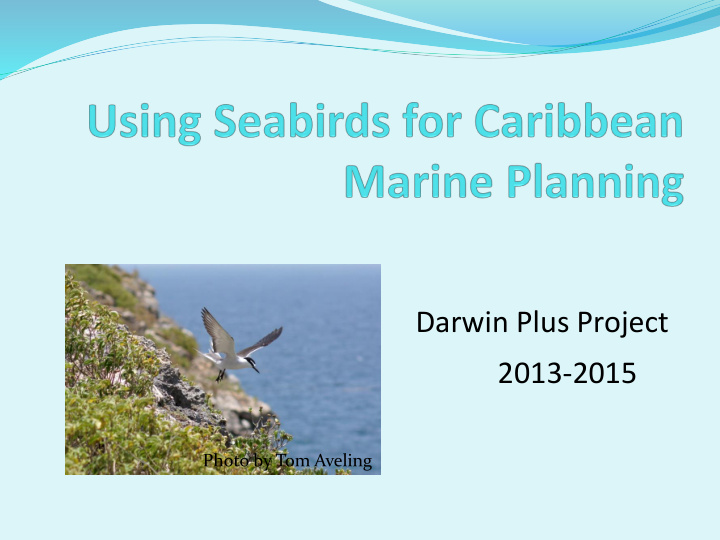



Darwin Plus Project 2013-2015 Photo by Tom Aveling
Project summary Two year project funded by the Darwin Plus Overseas Territories Environmental Fund Collaborative project of the University of Liverpool, RSPB, Anguilla National Trust, Jost Van Dykes Preservation Society (JVDPS) and National Parks Trust of the Virgin islands (BVI) Supported by BVI Government’s Department of Conservation & Fisheries and the Anguillan Government’s Department of Fisheries & Marine Resources
Aims of project • Provide comprehensive data on the at-sea distribution of important seabird populations • Work with ANT & JVDPS to establish seabird monitoring programmes • Identify threats facing seabirds in each territory • These data will be made available for use to enhance strategic sustainable marine planning and marine protected area designation
Why study seabirds..... Photo by Tom Aveling
1) Status of seabirds Globally seabirds are the most threatened of all avian groups Schreiber and Lee (2000) cite the loss of seabirds from tropical islands as 90-99% In the Caribbean region, seabird populations were believed to be 10 times greater pre-European contact
2) Suffer from a wide range of human impacts
3) Good indicators of the health of marine environment Large and conspicuous so “easy to monitor” e.g. seabird breeding failure can be caused by overfishing or changes in ocean conditions (sea surface temp) Monitoring at the breeding colony and at-sea movements can reveal changes in the marine environment
Data collection
Survey Data Anguilla National Trust, all staff and volunteers fully competent in seabird identification, stages of breeding cycle etc.. Surveys as part of this project and base-line surveys in 2012 reveal Dog island as THE MOST important out of 200 islands in the Lesser Antilles based on globally important populations & number of birds (280,000 breeding adults every year) Red-billed tropicbird identified as globally important on Dog Island & PPW Bridled tern globally important on Sombrero
Tracking Data Attach GPS data loggers to globally and regionally important seabirds from key breeding sites over two breeding seasons to identify feeding areas. Study sites: Dog Island, Prickly Pear West and Sombrero
Example tracking maps
Types of logger used Range of loggers used from the relatively cheap IGOTUs, to more expensive remote download loggers 3% of body weight rule Attached with sticky tape
Marine Important Bird Areas BirdLife International have defined over 1600 terrestrial IBAs for seabirds Recent move in identifying marine IBAs: at-sea areas where significant proportion of a globally important population forage Developed marine IBA R script to identify these important at-sea areas for globally important populations
Analysis
PPW marine IBA Brown booby, PPW
Sombrero marine IBA Brown booby, Sombrero
Dog Island marine IBA Brown booby, Dog Island
Regionally important populations Masked booby and Brown booby, Sombrero
Relate foraging tracks to environmental/oceanographic data
Uses for this data..... Identification of important foraging areas and breeding sites can help Government authorities with marine spatial planning - Marine protected area designation -Protection of terrestrial sites, Dog Island -Assess impacts of management/site protection
Uses for the data For example . BVI Magnificent frigatebirds – targeted education campaign Puerto Rico- Para La Naturaleza using data to raise awareness of marine parts BEST project regional identification of marine corridors within the European OT islands Parcs naturel, SXM interested in overlaying with marine park zones
Outputs 1) Monitoring guide and threat report 2) Publications: Foraging areas of brown boobies based on 2012 pilot data Sooty tern paper submitted to Bird study End of project paper in draft – soon to be sent to project partners for review
What will happen to the data? Survey data held in ANT’s biodiversity database ANT updated population estimates to BirdLife International’s database All foraging tracks uploaded onto www.movebank.org and BirdLife International’s Seabird Tracking database: www.seabirdtracking.org/ All data on the CDs and available on request from ANT or Louise
What will happen next? Further survey work on Dog Island, supported by the Anguilla National Trust and University of Roehampton Fellowship programme Share data with neighbouring islands (e.g. Saba and SXM) Further Darwin plus funding for seabird restoration work in BVI
Any questions...... Website: www.caribbeanseabirds.org.uk Contact: louise.soanes@liverpool.ac.uk
Recommend
More recommend